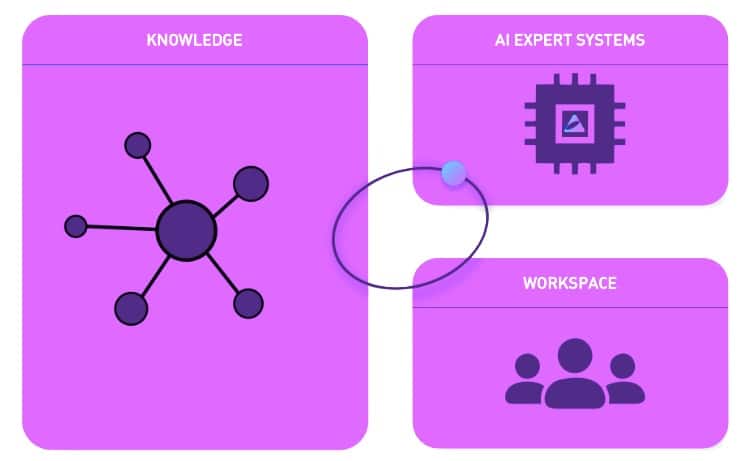Modern science faces a paradox: exponential information growth coupled with cognitive bottlenecks in knowledge synthesis. This paper proposes a Knowledge IDE—an integrated environment combining structured knowledge bases, specialized AI agents, and collaborative workspaces—to transform how we create, connect, and validate scientific insights.
Introduction
Modern science and other knowledge-intensive domains face a paradox: we are producing more information than ever, yet our ability to create new knowledge from that information is bottlenecked. Thousands of research articles and datasets are published daily, far outpacing any individual’s capacity to synthesize them. This information overload creates deep specialization, trapping critical insights within disciplinary silos and hindering the cross-pollination of ideas. Critical insights often lie at the intersections, yet they go unseen.
The result is an epistemic bottleneck: our collective knowledge grows, but our capacity to connect it remains limited by human cognition.
The arrival of generative AI complicates this picture. On one hand, it threatens to flood the system with even more content; on the other, it gives us a glimpse of a possible solution. If designed thoughtfully, AI can serve as a reasoning partner—helping researchers integrate scattered signals, validate claims, and extend insights across domains. But this requires rethinking the tools we rely on today.
The Limits of Existing Tools
Today’s tools for knowledge work are a patchwork of disconnected solutions, each addressing only a fragment of the research lifecycle. This forces researchers to act as human middleware, manually bridging the gaps between systems and creating a disjointed workflow. The proposed Knowledge IDE is designed to overcome these limitations by examining why current approaches fall short:
- Point Solutions Lack Context: Literature discovery tools (e.g., Semantic Scholar, Elicit) are powerful for finding papers but operate in isolation. They have no persistent memory of a researcher’s existing knowledge, internal data, or project goals, leaving new insights disconnected from the team’s ongoing work.
- Generic AI Lacks Specialization: General-purpose chatbots (e.g., ChatGPT, Claude) provide fluent answers but lack deep scientific reasoning and are not grounded in a user’s private research data. Their outputs can be generic, miss crucial domain-specific nuances, and lack the rigorous source validation required for scientific work.
- Enterprise Platforms are Too Broad: Large-scale knowledge management suites (e.g., Microsoft 365 Copilot, Notion AI) offer organization-wide search but are not tailored to the iterative cycle of scientific inquiry: analysis, hypothesis, experimentation, and synthesis. Their AI features are often generic and fail to support the specialized tasks of a research team.
- Lab Notebooks and PKM Tools are Passive: Electronic Lab Notebooks (ELNs) are excellent for record-keeping, while Personal Knowledge Management (PKM) tools like Obsidian help individuals connect notes. However, both treat knowledge as a passive archive. They cannot actively analyze data, connect findings to the latest literature, or help generate new hypotheses.
In short, the current landscape is defined by a choice between tools that lack integration (each holding a piece of the puzzle) or those that lack intelligence (offering little support for high-level reasoning). This fragmentation places the entire burden of synthesis on the researcher, underscoring the urgent need for an integrated environment where knowledge is structured, shareable, and actionable.
An Integrated Development Environment (IDE) for Knowledge Creation
We propose a paradigm shift for knowledge work analogous to the one that transformed software development: the move from disparate tools to a unified Integrated Development Environment (IDE). A Knowledge IDE integrates the essential components of research—a structured knowledge base, intelligent agents, and a collaborative workspace—into a single, cohesive platform. By tightly coupling these elements, the IDE creates a “knowledge operating layer” that moves beyond static data storage to enable a dynamic, interactive, and intelligent workflow.

This environment is built on three core primitives:
1. The Knowledge Base: A Structured, Living Memory
At the heart of the IDE is the Knowledge Base, a structured representation of a research team’s collective intelligence. It goes beyond generic LLM training data by integrating public literature with the team’s private and often unstructured information—lab notes, experimental results, datasets, and internal documents. This creates a domain-specific and context-aware memory that serves two critical functions:
- Factual Grounding: It acts as a verifiable source of truth for the AI agents, dramatically reducing the risk of hallucinations and ensuring that generated insights are grounded in the team’s actual data.
- Long-Term Context: It provides a persistent, evolving memory of the team’s work, allowing the system to understand the history and trajectory of a project.
In essence, the Knowledge Base transforms scattered information into an organized, queryable asset—a “digital twin” of a team’s knowledge that makes AI augmentation relevant and trustworthy.
2. Agents: Specialized AI for Cognitive Tasks
If the Knowledge Base is the memory, Agents are the reasoning engine. These are specialized AI modules, powered by LLMs and other tools, designed to perform distinct cognitive tasks within the research lifecycle. Instead of a single, generic chatbot, the IDE deploys a suite of agents for specific functions:
- Literature Synthesis Agent: Scans and connects new publications to the existing Knowledge Base.
- Hypothesis Generation Agent: Identifies gaps, contradictions, or novel connections within the data to propose new research questions.
- Data Analysis Agent: Executes code to analyze experimental results and visualizes findings.
These agents operate in a goal-directed manner, chaining actions together and interacting with the Knowledge Base, external tools, and the user. Crucially, any new insights, analyses, or ideas generated by an agent can be fed back into the Knowledge Base, creating a virtuous cycle where every interaction makes the entire system smarter.
3. The Workspace: A Collaborative Human-AI Interface
The Workspace is the interactive canvas where researchers and AI agents collaborate. It is more than just a chat interface; it is a computational notebook designed for the iterative and often non-linear process of discovery. The Workspace allows users to:
- Conduct a Dialogue with Data: Seamlessly move between querying the Knowledge Base, directing AI agents, and analyzing their outputs (text, graphs, code).
- Maintain Context and Provenance: Preserve a complete history of the research process, making workflows transparent, reproducible, and easy to revisit.
- Enable Human-in-the-Loop Guidance: Allow researchers to steer, validate, and correct the AI, injecting the critical thinking and tacit knowledge that machines lack.
The Workspace transforms the interaction with AI from a simple Q&A into an immersive, creative partnership, ensuring that the human researcher remains firmly in control of the scientific process.
Broader Implications: Toward Democratized and Rigorous AI-Assisted Knowledge Creation
The shift toward a Knowledge IDE carries significant implications for how science is conducted, promising to make the research process more efficient, accessible, and reliable.
Augmenting Human Intelligence, Not Replacing It
A core principle of the Knowledge IDE is to augment, not automate, the researcher. While AI agents excel at rapidly synthesizing vast information, humans provide the essential creativity, critical judgment, and tacit knowledge required for true discovery. This partnership creates a “collective intelligence” where the system handles the cognitive heavy lifting of data processing and connection-finding, freeing researchers to focus on higher-level thinking, experimental design, and interpreting results. The IDE’s human-in-the-loop design ensures that the researcher always guides the scientific process.
Democratizing Access to Advanced Research
Currently, the ability to perform large-scale data analysis and literature synthesis is often limited to well-funded labs. By packaging these capabilities into an accessible platform, a Knowledge IDE can democratize research. Smaller teams, independent researchers, and even citizen scientists could tackle complex problems that were previously out of reach. This levels the playing field, empowering a wider range of thinkers to contribute to scientific discovery and innovation.
Ensuring Scientific Rigor and Reproducibility
A common concern with AI in science is the “black box” problem. The Knowledge IDE is designed to counter this by prioritizing transparency and provenance. Because all AI-generated insights are grounded in the user’s trusted Knowledge Base, the system can always trace a conclusion back to its source data or literature. The Workspace maintains a complete, auditable log of the research workflow—from initial query to final analysis—making experiments more transparent and easier to reproduce. This built-in rigor helps maintain high standards of scientific validity in an age of AI-augmented research.
Accelerating Discovery and “Hypothesis-at-Scale”
By automating routine knowledge tasks, the IDE can dramatically accelerate the pace of discovery. Researchers can spend less time searching for information and more time exploring ideas. The system’s ability to identify novel connections across disciplines and generate data-driven hypotheses allows for “hypothesis-at-scale,” where numerous research questions can be formulated and preliminarily evaluated in a fraction of the time it takes today. This creates a more dynamic and efficient cycle of inquiry, leading to faster breakthroughs.
Challenges and Considerations
While the vision for a Knowledge IDE is compelling, its implementation presents significant practical and philosophical challenges that must be addressed.
Technical Hurdles and Data Privacy
The greatest technical challenge lies in creating and maintaining the Knowledge Base. Transforming unstructured, private research data into a reliable, structured format is a complex task. Furthermore, ensuring the security and privacy of this sensitive information is paramount, requiring robust access controls and potentially on-premise deployment options.
User Adoption and Skill Development
A Knowledge IDE is a sophisticated tool. Overcoming the learning curve will require intuitive design and effective training. Scientists will need to develop new skills in “prompt engineering” and learn how to collaborate effectively with AI agents. A key challenge is fostering critical engagement, ensuring researchers use the IDE to augment their thinking rather than blindly accepting its outputs.
Defining and Measuring Success
The impact of such a tool cannot be measured by traditional academic metrics like publication counts alone. New methods for evaluation will be needed to capture its true value, such as “time to insight” or the rate of successful hypothesis generation. Demonstrating a clear return on investment will be crucial for widespread adoption.
Open Infrastructure vs. Proprietary Platforms
A critical question for the community is whether these tools will develop as an open, interoperable ecosystem or as closed, proprietary platforms. An open approach would foster collaboration and prevent a few large entities from controlling the “operating system” for science, but it requires significant coordination and community effort.
Conclusion
In conclusion, the transformation enabled by AI-assisted knowledge creation is poised to be as significant as the introduction of computers to data analysis decades ago. We stand at the cusp of an era where intelligent knowledge environments could become the norm in labs, think tanks, and even classrooms. The convergence of structured knowledge, agentic AI, and collaborative interfaces can turn the practice of research and learning into a more efficient, inclusive, and creative endeavor.
It carries the promise of not just faster science, but fundamentally better science – where thoroughness and breadth are not sacrificed for speed, and where humans can push the frontier of knowledge armed with powerful AI tools that were unimaginable just a few years ago. The approach presented here demonstrates a viable path forward. It validates that codified knowledge and structured cognition can be combined to tackle the epistemic challenges of our time.
By reimagining our tools for integrated, intelligent environments, we equip ourselves to handle the complexity and volume of modern knowledge with confidence. In doing so, we stand to unlock not only faster progress in science and technology, but also a more inclusive and collaborative model of innovation – one where human creativity is amplified by machines that understand and support our highest intellectual endeavors.
The lab of the future, and indeed the think-tank or classroom of the future, may well be an open IDE where minds and machines co-create knowledge side by side. The infrastructure is being laid today; the next critical step is for the community to embrace, evaluate, and iteratively improve these systems, ensuring they truly serve as a force multiplier for human intellect in the pursuit of discovery.
References
- Accelerating scientific breakthroughs with an AI co-scientist – Google Research Blog
- Scientific Method: A Historical and Philosophical Introduction – Routledge Academic
- OECD: Combining collective and machine intelligence at the knowledge frontier
- Transforming R&D with agentic AI: Introducing Microsoft Discovery

